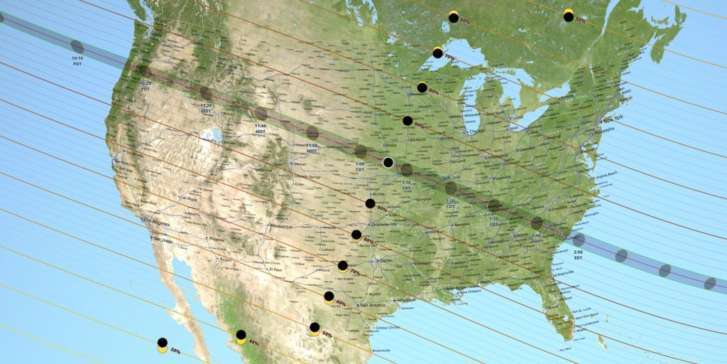WASHINGTON — Happy first day of summer! It officially started for the D.C. region Wednesday morning at 12:24 a.m. EDT.
Coincidentally, Wednesday also marks 60 days to the solar eclipse of Aug. 21, 2017 that will cross the United States from the West Coast to the East Coast — an event that hasn’t happened in 99 years.
In preparation for the solar eclipse, which may be the most watched in history, NASA and other federal agencies participated in a joint news conference at the Newseum. Representatives from NASA, National Oceanic and Atmospheric Administration, National Park Service and Federal Highway Administration provided valuable information on the eclipse, weather, logistics and safety.

Over 200 million people live within one day’s drive to the “path of totality.” This is the narrow band only 70-miles wide where the dark umbral shadow of the moon will race across the Earth’s surface at almost 3,000 mph at the start of the eclipse in Oregon to 1,500 mph in South Carolina at eclipse end.
I’ll share the science of “Eclipse 2017” in another column. (Courtesy NASA)
 \n","caption":"
\n","caption":"Over 200 million people live within one day\u2019s drive to the “path of totality.” This is the narrow band only 70-miles wide where the dark umbral shadow of the moon will race across the Earth\u2019s surface at almost 3,000 mph at the start of the eclipse in Oregon to 1,500 mph in South Carolina at eclipse end.\n I\u2019ll share the science of “Eclipse 2017” in another column. (Courtesy NASA)\n"},{"type":"photo","media":" Cities and national parks \u2014 along with the 14 states in the path of totality \u2014 have been preparing for the expected large crowds. Hotels and lodging facilities have been booked and sold out two years in advance. NPS and FHWA cautioned that eclipse seekers must plan in advance to make sure they can get to their viewing location: \u201cYou just can\u2019t pack up and go on the day of the eclipse.\u201d\n Plan ahead.\n (Thinkstock)\n"},{"type":"photo","media":" Our own Shenandoah National Park will be watching the solar eclipse as part of their 2017 Night Skies Festival, which takes place Aug. 18-21. (Photo by NASA\/Bill Ingalls via Getty Images)\n"},{"type":"photo","media":" Safety first\n During the news conference, eye safety in watching the eclipse properly and safely was emphasized and reinforced by multiple multimedia presentations.\u00a0Other safety aspects were covered as well.\n Martin Knopp, associate administrator of the Office of Operations in the FHWA at the U.S. Department of Transportation in Washington, cautioned that motorists must keep their eyes on the road and not watch the eclipse while driving.\n Many interstate highways are in the path of totality and there may be cars pulled over on the shoulders with people out of their cars looking at the eclipse. FHWA is an excellent source of information if you are planning on driving to the eclipse.\n (AP Photo\/Tim Ireland)\n"},{"type":"ad","media":" Biggest crowds and weather prospects\n When I asked the panel where they expected the greatest concentration of people to watch the eclipse, they speculated that Nashville, Tennessee \u2014 which will experience totality \u2014 and national parks along the path of totality will have the biggest crowds.\n Vanessa Griffin, director of the NOAA\u2019s Office of Satellite and Product Operations in Suitland, Maryland, discussed weather prospects during the eclipse. Because this involves the entire U.S., her best advice was to check \u201cyour local weather stations two-three days before the eclipse.\u201d Of course, with the eclipse taking place at the height of summer heat, humidity and clouds\u00a0can be the order of the day for much of the country.\n The good news is that when I asked, \u201cHow can we see the eclipse if it is cloudy?\u201d Dwayne Brown, NASA Headquarters Public Affairs, replied, \u201cNASA will provide a nonstop live view of the eclipse from west to east using NASA assets.” (Thinkstock)\n"},{"type":"photo","media":" Partial solar eclipse only in the D.C. area\n In the D.C. area, you can witness a partial solar eclipse only, since we are not in the path of totality. In D.C., the new moon will start to cross the face of the sun at 1:17 p.m. EDT and obscure 85 percent of the sun at maximum eclipse, which occurs at 2:42 p.m. EDT. The eclipse ends at 4:01 p.m. EDT.\n Follow my daily blog to keep up with the latest news in astronomy and space exploration. You can email me at skyguyinva@gmail.com. The post What you need to know about solar eclipse 2017 in August appeared first on WTOP. \n","caption":"
\n","caption":" \n","caption":"
\n","caption":" \n","caption":"
\n","caption":" \n","caption":"
\n","caption":" \n","caption":"
\n","caption":"


